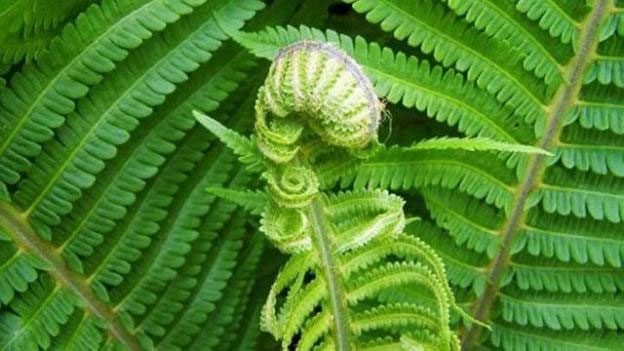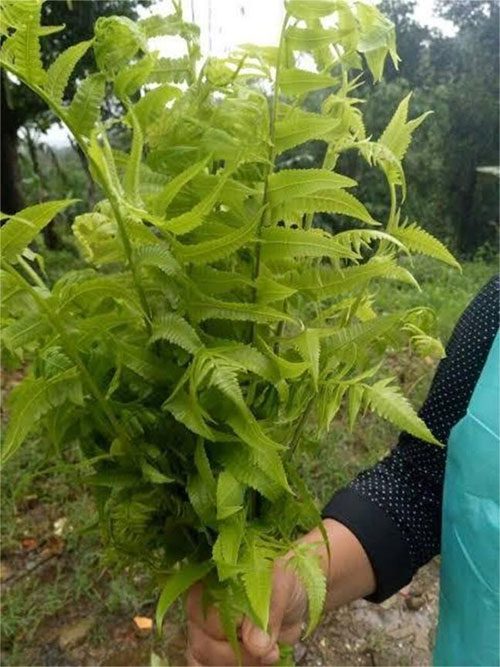Young leaves and shoots of ferns are used as a type of food that not many people were aware of before.
For those who are starving (not receiving nutrition) and not practicing any meditation or spiritual discipline, the body will use glycogen for energy during the first 24 hours. The amount of glycogen stored in the body can only sustain energy for about 12 hours; after that, glycogen is sourced from protein.
From the 17th day onward, if the body continues to be deprived of food, it will utilize stored fat to provide up to 90% of the body’s energy. Therefore, the duration of fasting depends on the physical condition of each individual, with some cases being able to fast for up to 8 weeks. Humans can survive for a long time without food, but without water, they will perish quickly (within 3 to 5 days).
Ferns Used as Edible Greens Worldwide
The young parts (typically the curled fronds) of certain fern species are consumed as vegetables. The most common among these are:
- Ostrich Fern (Matteuccia struthiopteris), known for its pleasant flavor, often compared to asparagus;
- Lady Fern (Athyrium filix-femina), used in herbal medicine for respiratory and digestive ailments;
- Cinnamon Fern (Osmunda cinnamomea);
- Royal Fern (Osmunda regalis);
- Stenochlaena palustris, regarded as a delicious dish;
- Japanese Fern (Osmunda japonica) is a nutritious vegetable known as “quyết thái”;
- Edible Fern (Athyrium esculentum), a familiar dish among some ethnic groups in Vietnam, used to treat common ailments like colds, coughs, sore throats, and to relieve heat and detoxify;
- Bracken Fern (Pteridium aquilinum), which is toxic if not fully cooked. It is best avoided due to its content of the carcinogenic compound ptaquiloside;

Ferns used as edible greens.
In spring, when ferns have many young shoots, various types of ferns are commonly prepared as spring vegetables. Ferns have been part of the traditional diet in much of northern France since the early Middle Ages, across Asia, and among Native Americans for centuries. They are also part of the diet in the Far East of Russia.
In Indonesia, young ferns are cooked in a rich coconut sauce, spiced with chili, ginger, lemongrass, turmeric leaves, and other spices. This dish is called gulai pakis or gulai paku, originating from the Minangkabau people of Indonesia.
In the Philippines, the young leaves of edible ferns are a delicious dish often prepared as a salad with tomatoes, salted eggs, and a simple oil and vinegar dressing.
In Japan, ferns are a highly regarded food, and grilling the fern shoots is believed to neutralize any toxins in the greens. Fern species (Osmunda japonica) are called zenmai, while ostrich ferns (Matteuccia struthiopteris) are called kogomi, typically consumed in spring.
In the Indian subcontinent, ferns are found in the Himalayan states of northern and northeastern India. They are prepared by stir-frying, pickling, or mixing with rice.
In Nepal, ferns are a seasonal food known as and served as a vegetable side dish, often cooked in local butter or pickled.
The ostrich fern (Matteuccia struthiopteris), locally referred to in North America as “fiddleheads”, is a traditional vegetable that has been commercially harvested for a long time. Fresh young ferns are typically available for only a few weeks in spring and can be quite expensive. However, pickled and frozen ferns can be found year-round in stores. They are often steamed, boiled, or sautéed, or used as an ingredient in various sauces.
The Maori historically consumed the young shoots of ferns known as pikopiko, which may refer to several fern species in New Zealand.
Nutritional Value, Benefits, and Risks of Ferns

Ferns are rich in nutrients.
Ferns are low in sodium but high in potassium. Many types of ferns also contain the enzyme thiaminase, which breaks down thiamine (vitamin B1). This can lead to a deficiency of vitamin B1 if consumed excessively.
Furthermore, there is some evidence suggesting that certain fern species are toxic, such as the bracken fern (Pteridium aquilinum). Ostrich ferns (Matteuccia struthiopteris) are not considered carcinogenic, although there is evidence that they contain an unidentified toxin.
To safely consume ferns, it is advisable to remove the brown outer layer, rinse thoroughly in cold water, and then boil or steam them. Boiling reduces bitterness and the levels of tannins and toxins. The recommended cooking time is 15 minutes for boiling and 10 to 12 minutes for steaming.
According to traditional medicine in some Eastern countries, ferns are often used to treat respiratory, digestive, and joint conditions, possessing cooling properties; they are believed to help clear heat, detoxify, and promote bowel movements.



















































